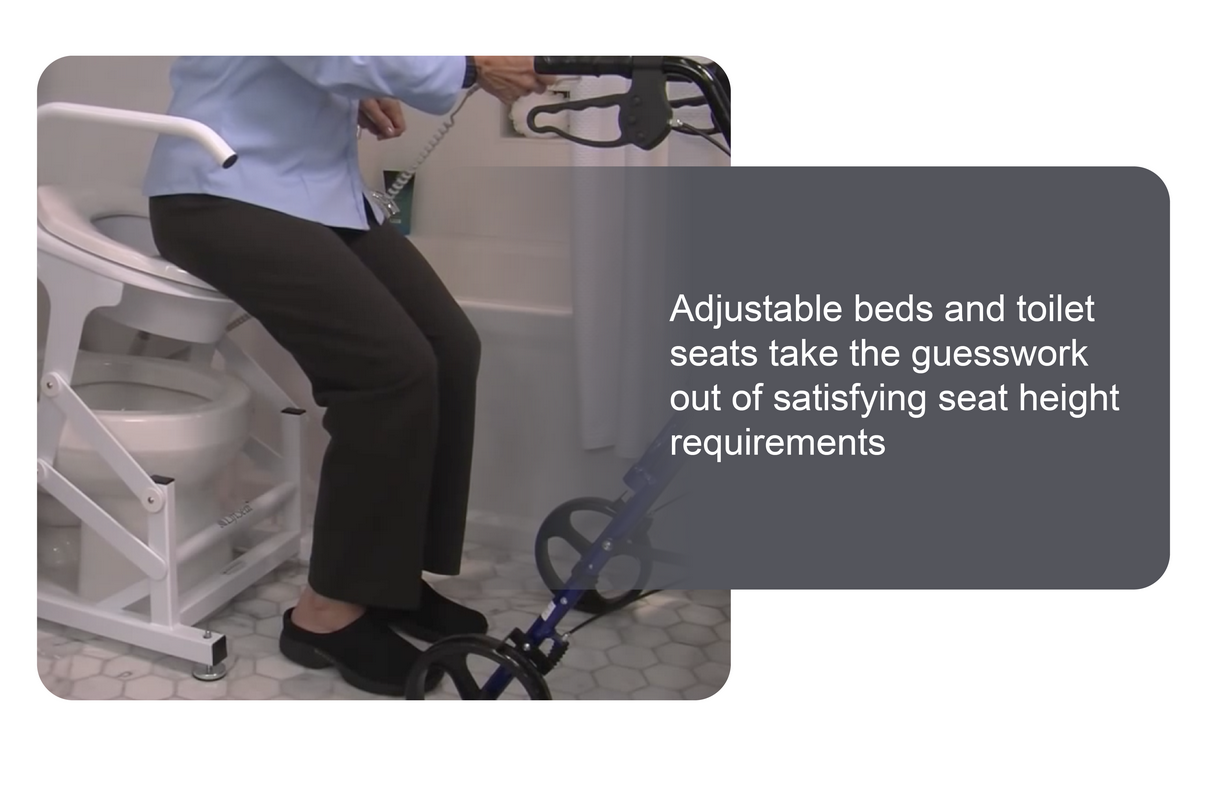Goldilocks Got it Right: Why Seat Height Needs to Be “Just Right”
08/04/2022
Difficulty standing is something most of us will experience as we age. We may groan a bit more as we get out of bed or notice that getting up off the toilet requires more effort than it once did. This change is natural, but that doesn’t mean we have to take it sitting down. Trouble standing (and sitting) can cause falls, which are not only a real pain in the rear but can cost big bucks.
This action of standing up, often referred to as a “sit-to-stand” motion in healthcare, has been studied extensively, and many experts agree that there is an ideal seat-height – somewhere around 120% of your lower leg length (LLL).
Anyone who has tried to get up from a seat that is too low knows how much harder it is. The added force needed to rise puts more strain on your muscles and joints and it also makes it harder for anyone who may be helping you.
Raising seat height seems like a relatively easy solution to this problem. Simply raise your bed, add a riser to your toilet seat, and maybe an extra cushion or two on your favorite chair, right? Wrong. What many people don’t realize is that seats that are too high can also pose problems –and increase your likelihood of falling.

What the Research Shows
A group of researchers working with elderly nursing home residents wanted to take a deeper look at the impact of seat height on fall risk, specifically related to bed and toilet height. The study looked at data from a few different nursing homes, and correlated falls with various factors involved.
The researchers identified several interesting findings. Most of the residents (a total of 94%) had beds that were too high (above 120% of LLL). A mere 6% had beds that were in the recommended height range for safer transfers. While the researchers note that bed height alone is not a cause of falls, they do acknowledge that is likely plays a role, adding “there were only eight serious injuries, all of which occurred in those whose bed heights were greater than 120% of lower leg length.”
In terms of toilet height, it appears that most residents had seat heights in the recommended range. That being said, about 45% still had toilets seats that were too high.
The study then went on to discuss possible solutions for ensuring easier access. Simply making the beds lower is not good, they concluded. Beds that are too low make getting up more difficult and are “are not ergonomically optimal for nursing staff providing care and places them at risk for injury.” Additionally, because height is variable among individual residents, it’s difficult to even recommend a range of heights that would be appropriate for everyone.
The best solution, they agreed, is adjustability - both for beds and toilets. Since optimal seat height is based on an individual’s LLL, it makes sense that everyone’s optimal seat height is different.

For instance, the researchers observed that while “toilet height was more likely than bed height to be in the optimal range for STS performance (54.8% vs. 6.1%)”, and that “this height range [of a 17- to 19-in. floor-to-bowl rim height] would accommodate almost all of the participants in this study”, this was still leaving certain residents vulnerable, citing that “this height would be too high for the 24 residents (nearly 10% of the population at the nursing homes) with lower leg lengths less than 14 in.”
Translating Institutional Research into At-Home Help
The findings of this study are certainly interesting, but can they be used to help people living at home too? Absolutely.
The researchers concluded that adjustability based on individual needs and characteristics is best. Adjustable hospital beds, like those referenced in the study, are widely available for at-home purchase. While both manual and electric options are available, electric is much easier to use so you will be more likely to adjust the bed as needed. Beds with manual cranks are often cumbersome and can require significant strength to operate, so they can discourage the frequent adjustment needed to ensure maximum ergonomic benefit.
Adjustable toilet seats, also known as “electric toilet lifts” or “powered toilet lifts”, are a relatively new option. Initially used in hospitals and at long-term care facilities, they have been modified for at-home use. Powered toilet lifts work by gently lowering the user onto the toilet and then raising back them up again. These lifts not only offer the benefit of adjustable seat height, but also give complete support throughout the sit-to-stand motion – often eliminating the need for assistance from a caregiver.
The LiftSeat Powered Toilet Lift is a popular choice. Due to its ease of installation, use, and customization, the LiftSeat is a good fit for most patients and their caregivers and was even awarded the “Today’s Caregiver Friendly Award”. LiftSeat offers a few different configurations based on your height, weight, and specific needs, but they make it easy to find the perfect fit. You can either use their handy online form and input all your requirements, or you can give them a call (877-665-4381) and talk with their dedicated specialist that can walk you through everything.
So, if you or a loved one struggle to stand up, do yourself a favor and listen to the experts when it comes to seat height. Consider adjustable options for your bed and toilet to get your seat height “just right” and minimize your risk of falling.
References:
1. Capezuti, E., Wagner, L., Brush, B. L., Boltz, M., Renz, S., & Secic, M. (2008). Bed and toilet height as potential environmental risk factors. Clinical nursing research, 17(1), 50–66. https://doi.org/10.1177/1054773807311408
This content is not intended to be a substitute for professional medical advice, diagnosis, or treatment. Always seek the advice of your physician or other qualified health provider with any questions you may have regarding a medical condition.